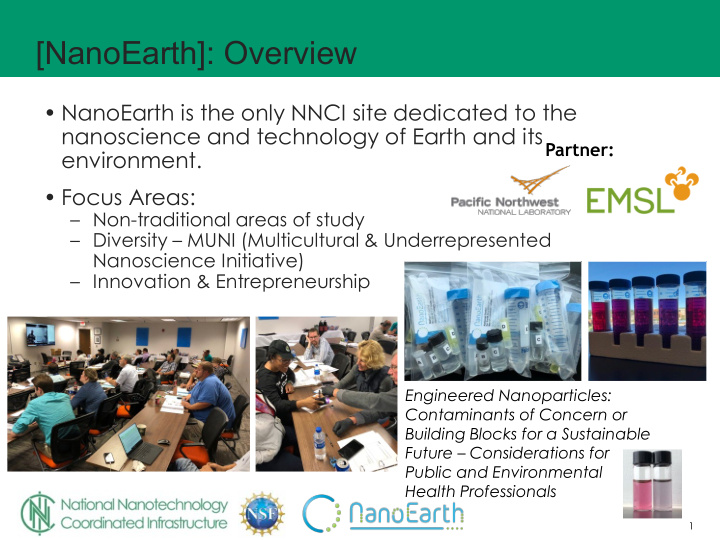



[NanoEarth]: Overview • NanoEarth is the only NNCI site dedicated to the nanoscience and technology of Earth and its Partner: environment. • Focus Areas: – Non-traditional areas of study – Diversity – MUNI (Multicultural & Underrepresented Nanoscience Initiative) – Innovation & Entrepreneurship Engineered Nanoparticles: Contaminants of Concern or Building Blocks for a Sustainable Future – Considerations for Public and Environmental Health Professionals 1
[NanoEarth]: Personnel Updates •Retirement of Founding Site Director Michael Hochella – Michael Hochella (PNNL) – Director of User Development •New Site Director – Mitsuhiro Murayama, Professor of Materials Science and Engineering & Geosciences Adjunct •New Deputy Director – Linsey Marr, Professor of Civil & Environmental Engineering 2
Research Highlight: Industry Collaboration: Scalable Removal of Nanoparticles from Wastewater Nano Waste Effluent • Small, woman-owned company located in Appalachia (Wise Co., VA) • NanoEarth demonstrated effectiveness of MicroEvap™ purification technology MicroEvap™ • Supports the company to expand markets Technology and secure SBIR funding 3
Research Highlight: Abiotic synthesis of graphite in hydrothermal vents • The structure and origin of an old component of deep marine organic carbon has been a mystery. • Identifying the sources, transport pathways, and fate of this relatively old carbon is key to understanding the dynamics of the marine carbon cycle. • This study reveals that the old carbon TEM images of reduced carbon is graphite that originates from particles reveal that they are graphite originating from hydrothermal vents, and NanoEarth hydrothermal vents. supported nanoscale characterization. Estes, E., Berti, D., Coffey, N.R., Hochella, M.F., Jr., Wozniak, A.S., and Luther, G.W., III (in review) Abiotic synthesis of graphite in hydrothermal vents. Nature Geosciences. 4
[NanoEarth]: Education and Outreach Nanoscience Professional Development Workshop – 2 days of instruction and hands-on activities – Teachers received lab supplies for their classroom & access to a Google Drive full of resources Assessment: – Content Rating: 9.3/10 – Reach: 16 teachers impacting over 1,130 students per year “Great workshop! I have been to many over my career and this workshop is one of the best!” 5
[NanoEarth]: Impact Oct 2017- Sept 2018 FUNDING REACH NSF Directorates # of projects from each funding source # of users OISE 1 120 105 SBE 0 100 MPS 12 80 57 GEO 4 60 51 47 42 ENG 35 25 40 31 24 21 20 16 HER 2 20 9 9 8 8 7 5 5 4 2 1 1 0 0 CISE 0 1 BIO 6 0 10 20 30 # of projects # of PIs included in count: 111 # of PIs funded by NSF: 38 # of users: 219 # of users funded by NSF: 105 6
[NanoEarth]: Network Collaboration Natural, incidental, and engineered nanomaterials and their impacts on the Earth system • Comprehensive Science review designed to inform the general science community • NNCI Sites – NanoEarth+partner PNNL, MONT, NCI-SW An estimated global accounting for all natural, incidental, and engineered nanomaterials on/in Earth’s surface and atmosphere. Hochella, M.F., Jr., Mogk, D.W., Ranville, J., Allen, I.C. , Luther, G.W. , III, Marr, L.C., McGrail, B.P. , Murayama, M., Qafoku, N.P., Rosso, K.M., Sahai, N. , Schroeder, P.A., Vikesland, P., Westerhoff, P., and Yang, Y. (2019) Natural, incidental, and engineered nanomaterials and their impacts on the Earth system. Science 363, eaau8299. 7
[NanoEarth]: Panel Discussion Aligning NNCI with National Research Priorities •Catalyze interest and investment in fundamental research •Continue to focus on diversity •Build collaborations with industry and other agencies •Earth & Environmental Sciences requires a convergence of disciplines to tackle global and long-term issues • Fate and Transport • Life Cycle Assessment • Ecotoxicology • Nanobiosensors • Environmental treatment 8
Panel Discussion – Collaborations Beyond NNCI • Challenge: Funding to support sustainable interaction – e.g. exchange of technical and administrate staff • Challenge: Time/funding/reporting cycles can vary internationally – Can be difficult to grow a seed project that has high potential impact research • Suggestion: Similar goals and expanded potential – Find a collaboration partner where you both benefit – Example: Nanoscience program at Virginia Tech 9
Recommend
More recommend